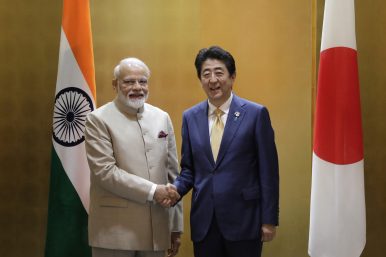By Bonnie Bley
Japanese Prime Minister Shinzo Abe and Indian Prime Minister Narendra Modi are keeping busy. Just a week after being courted by G-7 members in Biarritz, France they were off to Vladivostok for the Eastern Economic Forum hosted by Putin this week. Their attendance at multilateral forums is requisite these days. Amid global fixation on the gridlock between the United States and China, countries are increasingly looking to Abe and Modi to guide the way.
Recent moves by Tokyo and New Delhi to work closer together along economic and security avenues have been welcomed by the region. And with reason. The Lowy Institute’s Asia Power Index – a data-backed study of power across 25 countries in Asia – puts Japan and India as the third and fourth most powerful countries in Asia after the United States and China. The two countries are neck-and-neck, with only a 1.5-point difference between them.
As the power differential between the U.S. and China narrows, the role of countries like Japan and India in reconfiguring the regional order has taken on a new importance. There is a significant degree of convergence in their interests: Aside from having territorial disputes with China, both are committed to the nascent Indo-Pacific vision, enduring U.S. engagement in the region, and deepening ties with like-minded powers such as Australia, Singapore, Vietnam and, of course, each other. Perhaps most importantly, they share the desire to avoid an entirely Chinese-led order.
But a look below these surface-level findings reveals that despite their apparent parity, Japan and India are major powers for very different reasons — in fact, the two countries are mirror images of one another.
While New Delhi enjoys the benefits of size, Tokyo exploits the perks of networks. Japan has proven itself to be an established diplomatic heavyweight: with 160 embassies and permanent missions globally, it comfortably exceeds India’s 126. Meanwhile the size of India’s diplomatic corps is on par with New Zealand’s, despite having almost 280 times the population size. Abe ranks first in Asia for political leadership according to a qualitative assessment by regional experts, while Modi lags in fifth place behind China, Singapore and Malaysia. On the multilateral level, aside from establishing the Asian Development Bank (ADB), Japan is the third largest contributor to the United Nations. India is 22nd.
Demographically, however, their fortunes reverse. While Japan is taking rare steps toward loosening migration restrictions, India rendered 1.9 million people living in Assam essentially stateless this week. These contrasting policies reflect their divergent demographic destinies: while Japan is set to lose 19 million people of working age between now and 2045, India is set to gain 232 million – bringing labor dividends in the region of $2.5 trillion. Their respective population predicaments are evident in their armed forces too: India’s total military personnel exceeds that of Japan, the United States, Indonesia, South Korea and Australia’s troops combined.
But the differences in their defense capabilities don’t stop here. Most crucially, while New Delhi has opted for non-alignment in its security partnerships, Tokyo has oriented its military strategy around its treaty ally, the United States. This means that while India has shown considerable commitment to achieving a self-sufficient defense industry, Japan’s forces trade nearly six times the arms that India does, with 90 percent coming from the United States.
A secondary analysis from Lowy’s index, called the Power Gap, ranks Japan as the greatest “overachiever” in the index for a second year running. Its influence in Asia exceeds expectations considering its size and resources. Meanwhile India falls into the “underachiever” category, indicating significant resources but unfulfilled potential in its regional influence. What India has in size, Japan makes up for in statecraft.
As Modi put it on his visit to Japan a year ago, “A strong Japan benefits India and a strong India benefits Japan.” Beyond their common foreign policy goals, Japan and India’s differences might just be what makes this unlikely partnership effective. Japan and India illustrate that there is more than one way to approach a shifting regional order. While Japan may opt to mold the institutions and frameworks that dictate common rules of engagement, India can apply pressure with its growing economic and demographic largess. Likewise, India and Japan have guardian roles to play in the Indian and Pacific oceans respectively. As major powers, they need to figure out how they fit together and how they can best play the power game. While U.S.-China tensions ramp up, and the regional order hangs in the balance, strong cooperation between India and Japan will become increasingly necessary.
Bonnie Bley is a Research Fellow in the Lowy Institute’s Asian Power and Diplomacy Program.

